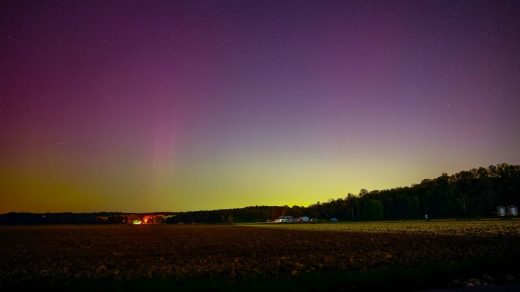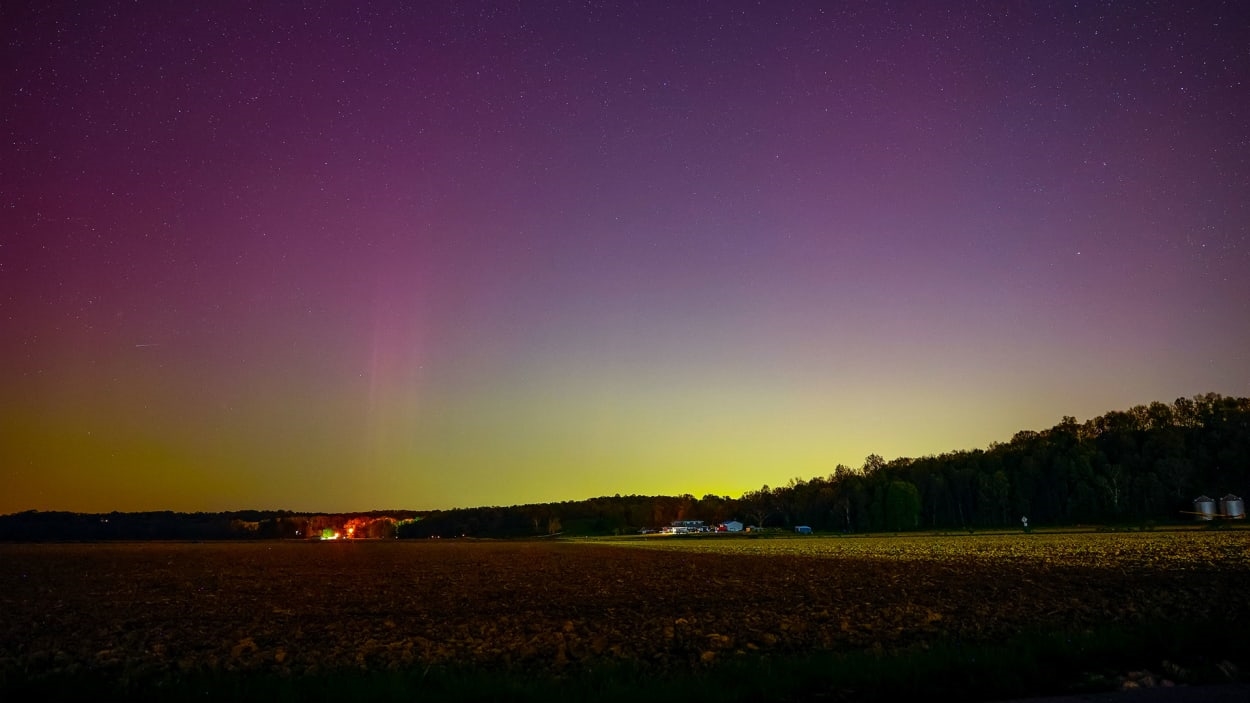Aurora borealis visibility: Why the northern lights are traveling so far south to the United States
This week, the dancing, shimmering, luminous aurora borealis descended from the sky, further south from its typical territory, where it could be seen even in parts of the United States from California to Colorado to West Virginia.
Known as the “holy grail” of skywatching, the washes of green, blue, purple, and yellow awed those who beheld it on recent nights—not just in the U.S., but also in England, as far south as Stonehenge—because as much as the lights are dazzling, they are also, for many people, associated only with geographies in the far and frigid north, like regions within the Arctic Circle, perhaps, or at least the snowy countries of Canada, Iceland, or Norway.
It was magical, then, to observe them gracing the skies above Arizona as warm winds swept the air. But it’s also not as rare as you might imagine. In fact, the last time the northern lights could be seen from the United States, outside of Alaska, was last month.
A scientist with the Space Weather Prediction Center at the National Oceanic and Atmospheric Administration (NOAA) told the New York Times that the aurora borealis can stretch closer to the equator about 100 times every 11 years.
What causes the lights to dance down from their snowy perches? It’s actually quite a violent phenomenon.
The science behind the aurora borealis was first theorized around the turn of the 20th century, by a Norwegian astronomer who proposed that the colors are produced as high-energy electrons, which shoot off from the sun and head for Earth at speeds of up to 45 million miles per hour, are deflected by the Earth’s magnetic field, which reroutes those electrons toward Earth’s poles. When the electrons collide with Earth’s ionosphere—a layer of upper atmosphere teeming with free ionized particles—energy is transferred to and fro, causing atmospheric molecules, such as hydrogen or carbon dioxide, to emit wavelengths of different colors.
The electrons reach such blazing speeds as they’re supercharged by surfing so-called Alfvén waves, formed by the undulating forces within the sun’s plasma emissions. When those electrons slam into atmospheric molecules, they transfer a jolt of energy to the electrons that are orbiting the molecules themselves, which then leap to new “excited” states of being, before falling back to their original states—simultaneously releasing the borrowed energy as a lightwave, with varying wavelengths based on the molecules’ chemistry.
Nitrogen, which composes 78% of our planet’s atmosphere, releases red wavelengths. Oxygen, which composes 21%, releases green wavelengths. All of the elements, in harmony, make the atmosphere fluoresce.
Most auroras exist in the “auroral zone,” in an oval that only expands between 10 to 20 degrees in latitude away from the North or South poles. But when bursts of energy from the sun are especially powerful—like big blobs of plasma with their own magnetic fields, known as coronal mass ejections—geomagnetic storms erupt within the ionosphere, enlarging the auroral oval to lower latitudes. These bursts often follow the sun’s 11-year solar cycle, which tracks sunspot activity. When it peaks, solar winds bombard us, creating geomagnetic storms that rage over and over again.
The current solar cycle, which began in 2019, is expected to peak in July 2025, meaning the chances of glimpsing a strong aurora borealis in shorts and a T-shirt will only get better. (The southern lights, aurora australis, are most often seen in the Antarctic but can creep north to Australia and New Zealand.)
At any given time, you can check the aurora forecast on the Space Weather Prediction Center’s website—down to 30-minute intervals.
And if you are entranced by the visions, know that you’re part of a storied tradition. It was Italian astronomer Galileo Galilei who first dubbed the aurora borealis—after the Roman goddess of dawn, Aurora, and the Greek god of winter, Boreas—in 1619.
But records of the celestial event had already been scrawled into a cave painting in France, 30,000 years ago. And the auroras have left their mark on history over millennia. In Inuit culture, a legend describes the lights as the souls of the dead playing soccer with a walrus skull, skittering across the sky. And in Norse mythology, Vikings believed they were lights reflecting off the armor of the Valkyrie, supernatural maidens who ferried warriors into the afterlife.
(20)



